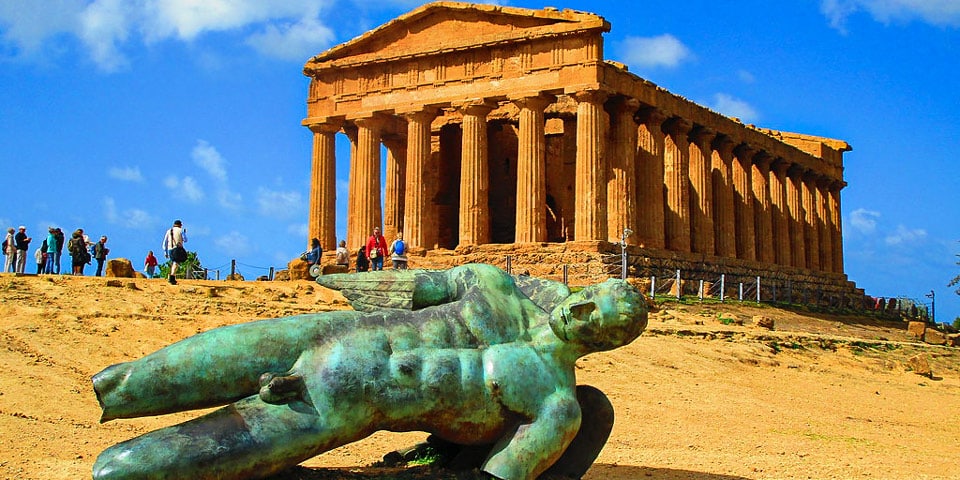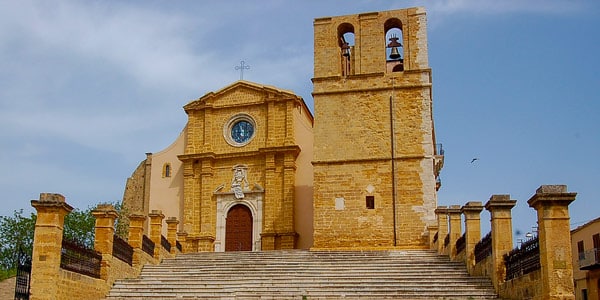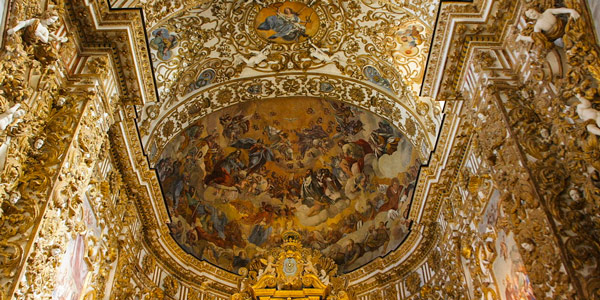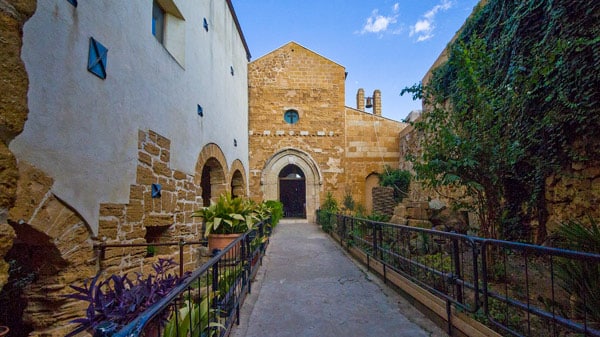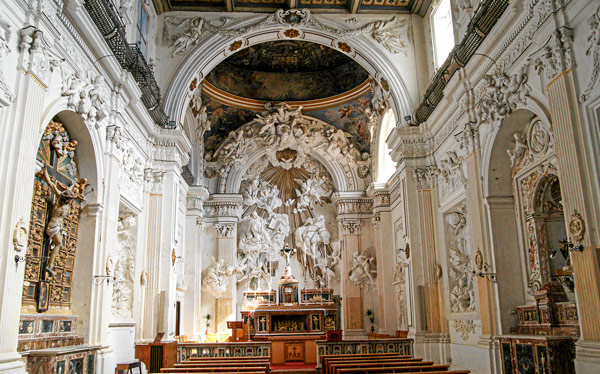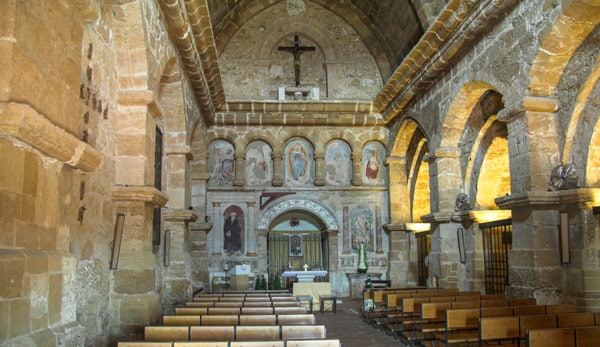Agrigento is the capital of the province of the same name on the southern coast of Sicily. The history of the city goes back more than 2.5 thousand years and begins in ancient times, of which today are reminded by the preserved in the picturesque Valley of the Temples architectural monuments of the Great Greece.
The unique heritage of Agrigento is the heritage of the whole world and is included in the list of sites protected by UNESCO. The beautiful climate of the Mediterranean Sea, the cultural and historical sites of different eras, the proximity of unusual and magnificent beaches have made the ancient city an attractive tourist destination.
The main attraction of Agrigento, which attracts tourists from all over the world, is the sacred area of the ancient Akragas – the Valley of the Temples (Valle dei Templi), which is an architectural park with surviving Doric temples. Their splendor and monumentality have amazed the imagination in the past and are still admired today.
Equally worthy of attention are the sites in the medieval part of Agrigento, which contain rare artefacts and real treasures of art, unknown to the general public.
Page Contents
Churches
The numerous churches of Agrigento create a unique ensemble of the ancient city, imbued with the flavor of different eras and cultures. During the Muslim domination, Christianity was almost destroyed, so after the expulsion of the Arab conquerors, the construction of Christian temples was very important and well-intentioned.
Today, in Agrigento alone, there are 26 parishes and as many saints to whom the temples are dedicated. The evening chime from all the churches creates an incredible experience.
Of great interest are the churches founded during the Middle Ages.
The Cathedral of San Gerlando
The Cathedral of St. Gerlando (Cattedrale di San Gerlando), located in the northwestern part of the old city on Via Duomo, is the main Catholic church in Agrigento.
The need for the church arose after the Muslim occupation that lasted from 829 to 1086 and greatly reduced the number of Christians in the city. The first Norman count of Sicily, Roger I, who came to power in 1088, founded in Agrigento an archdiocese (Arcidiocesi di Agrigento) that later became the largest in Sicily. He appointed his cousin Gerlando di Besançon as chief bishop, a position he held for 12 years until his death.
From 1159 the first bishop of Agrigento was venerated as a saint of the Catholic Church.
The building of the cathedral, which began in 1087, was completed in 1094. The religious building was originally dedicated to the Assumption of the Virgin Mary, but later, in 1315, it was renamed in honor of St. Gerlando.
The main cathedral was both a place of worship and a city fortification. Under the Normans, for defensive purposes in 1141 the Gualtieri Tower (Torre di Gualtiero) was built along the northern wall, which retained its original form until the XIX century. The large structures that added to the cathedral’s exterior were the imposing bell tower built in 1470, which was never completed. The Chapel of St. Gerlando, with its beautiful octagonal dome, appeared between 1627 and 1651.
During its several centuries of history the church was repeatedly rebuilt and reconstructed after destruction due to earthquakes and landslides, as well as due to the aftermath of historical events (Muslim uprisings and the wars of Frederick II). Each reconstruction brought new artistic expressions to the cathedral’s exterior and interior. Alongside the Romanesque style, other styles like Gothic, Renaissance and Baroque have gained a harmonious appearance and a certain zest as a result of the multicultural mingling.
Of particular value is the preserved wooden ceiling of the central nave, painted in 1511-1514 by Masolino da Floregia. The artist depicted figures and faces of saints, bishops, and the family coats of arms of the town’s nobility.
In the chapel of the temple there is a magnificent silver urn with the relics of St. Gerlando by Michele Ricca. The remains of the patron of the city were placed there with great solemnity and with the participation of the entire diocese in 1639; they remain there to this day.
The marble altar of the chapel is adorned with a statue of St Gerlando made by Rocco Jacopelli in the XVII century.
In the glass sarcophagus at the south door is the embalmed body of Saint Felice Martire.
Of artistic value are the murals and paintings of the masters of painting of the XVII century, Michele Blasco and Nunzio Magro.
Of great interest is the special acoustics of the church building. The word whispered at the front door will be well heard in the apse, which is at a distance of 85 meters, but the same effect in the opposite direction of the sound is not observed. According to local belief, this peculiarity was noticed by a painter working in the church, who heard all the secret thoughts of his wife during her confession.
Even more surprising is an artifact preserved in the church’s archives – a letter written in illegible handwriting by the devil himself for one of the nuns to tempt her.
Church of Santa Maria dei Grecchi
The Church of Santa Maria dei Greci (Chiesa di Santa Maria dei Greci), standing on the street of the same name on Girgenti Hill, is a medieval structure and dates back to the 12th and 13th centuries. Before it became a Catholic church, it belonged to the Greek Orthodox rite, so it retains the mention of Greci in its name.
The building has a simple and even somewhat austere appearance, which is characteristic of the architecture of the Norman period.
At its base was another religious building in Antiquity, the Doric Temple of Athena or Zeus, dating from the 5th century B.C. Traces of this ancient structure with its well-preserved steps (stylobate) and the remains of corrugated columns can be seen in the foundation and former cells of the church. From the ruins and the structure of the foundations, it was possible to determine that the ancient structure was 34.7 m x 15.10 m and was similar to the Temple of Concordia in the Valley of the Temples.
The religious building has three naves, of which the central one has a wooden ceiling with 14th century paintings. The walls show traces of 14th century frescoes depicting the Madonna and scenes from her life.
During the restoration work in the nineteenth century, the bodies of the dead members of the brotherhood of Santa Maria dei Grecia were found in the underground church, buried under the floor of the cell, in a very unexpected way: sitting on stone armchairs.
Church of Santo Spirito
The Church of Santo Spirito or Holy Spirit (Chiesa Santo Spirito) was originally part of the Cistercian order, which for its grandiose architectural masses was nicknamed Bataranni, which means “great abbey” in the local dialect.
The nuns remained in the building until 1866, when the new government of united Italy expropriated their abbey. The walls of the convent housed an orphanage and then a canteen for the poor, until in 1916 the state handed over part of the complex to the municipality of the city, after which major restoration work began.
The building of the church dates back to 1299 and is associated with the name of Marchisia Prefoglio, wife of Frederick I Chiaramonte (Chiesa Santo Spirito Agrigento), who after his death bequeathed the building to the Cistercians.
The architecture of the church belongs to a particular style of Sicilian Gothic called chiaramontano. The simple facade of Santo Spirito is formed by a high flat wall with masonry of limestone and sandstone with a beautiful polychrome effect characteristic of many Norman structures in Sicily. There are no decorations on the exterior of the church, except for the distinctive portal and the circular window above it, which, incidentally, has been preserved since the founding of the church. A door next to it leads up internal stairs to the second floor, where there are nuns’ bedrooms with the interior of the XVII century.
The building is not without an admixture of Arab architectural elements, which can be seen in the design of the lancet doorways and windows decorated with narrow columns and zigzag patterns.
The interior of the church consists of one nave and has no apse. Four columns support the choir, on which the nuns were seated during Mass. Lattice sections of the ceiling were also provided for better sound penetration during the chanting of the sisters of the order, who were not to be seen by anyone.
At the beginning of the 18th century, the interior decoration of the church underwent a great transformation, as a result of which it acquired a baroque look with rococo elements. The center of the composition was the ornate triumphal arch at the back of the main aisle. The interior features fine plaster moldings, which literally filled the entire space of the only aisle. The sculptor Giacomo Serpotta – a sculptor from Palermo who works in rococo style with moldings – is the creator of the three-dimensional paintings with biblical scenes and charming cherubs.
In the niche on the left wall at the entrance is a beautiful marble statue of the Madonna and Child by Renaissance sculptor Antonello Gagini.
The monastery of Santo Spirito is now open to the public. Of interest will be the small Ethnographic Museo Civico di Santo Spirito/Sezione Demo – Ethno – Antropologica, where you can see a model of the city, room decorations and handicrafts of the XVIII and XIX centuries.
Church of San Nicolas
The Church of San Nicholas is in the archaeological site of the Valley of the Temples and offers a splendid view of the architectural park of Doric monuments and the picturesque landscape.
The Christian church was built in the XII century on the ruins of an ancient antique structure and is one of the most beautiful Gothic buildings belonging to the Cistercians. The facade of the church is between two massive columns and has a large beautiful portal with several rows of vaulted arches and a magnificent wooden door made in 1531. The church has one nave with four chapels intended for the prayers of the monks.
The main attraction of the church is the marble Sarcofago di Fedra, now used as a baptismal font. The bas-reliefs of this marble masterpiece are admirable and considered the most exquisite example of ancient Greek art. For the sake of this treasure alone, it is worth visiting the church of St. Nicholas, as many admirers of ancient art did, among whom was Goethe. The belonging and authorship of the sarcophagus remain a mystery, which does not prevent us from admiring every little detail and the talent of the genius sculptor.
Map with sights of Agrigento
On the map I have marked all the main attractions, beaches, and hotels with good reviews.
Read also about the best beaches in Sicily.
What does Agrigento Look Like today?
The main city of the province of Agrigento is located on top of two gentle hills at an altitude of 230 m above sea level and covers 245.32 square kilometers. These hills were once separated by an artificial depression designed by the philosopher Empedocles to allow healthy air to circulate in the lower part of the city, for which malaria was a real scourge. The slope of the hills faces south and west overlooking the Mediterranean Sea, the distance to the coast just over 3 km.
The modern buildings of Agrigento surround the old city area which extends from east to west for 1.6 km and covers about 50 ha on the highest point of the hill.
The historical center has preserved the appearance of a medieval town with a complex labyrinth of narrow streets and small courtyards typical of Arab settlements. Norman palaces and churches as well as baroque buildings of Spanish origin intervene in the Oriental flavor. In Agrigento, the old neighborhoods are characterized by chaotic buildings of different styles, surprising with their unexpected mingling of cultures.
History of the City of Agrigento
Modern Agrigento is situated a few kilometers from the ruins of an ancient city known as Akragas, one of the largest and richest polities in Southern Italy. The settlement was founded in 582-580 B.C. by the people of Gela, natives of Rhodes and Crete. The prosperous ancient town of 465 hectares with a population of about 300,000 people had the structure of a Greek metropolis with majestic temples, agoras, theater, artificial pond and other benefits of a developed civilization.
The decline of Akragas began in 406 B.C., when the more powerful Carthage sacked and destroyed it. The city has not since returned to its former splendor.
In the following centuries its lands were ruled by the Romans, the Goths, the Byzantines and the Arabs. But since the fall of Rome, Sicily and Agrigento itself have remained aloof from the main events of history.
The original name Akragas was of Greek origin, from akros “peak” or “peak of the mountain”. In subsequent centuries, the name of the city changed with the rulers, becoming Agrigentum in Roman times, Kerkent in Arab Muslim conquest, and Girgenti under the Normans, a name retained until the 20th century.
It was the Byzantines who decided to abandon the old town and found a new settlement on top of the old acropolis. The move away from the coast was caused by the frequent Saracen raids from the sea, the proximity to the new harbor, and the impossibility of restoring the ruined ancient buildings. The city still fell into easy prey to the Muslims of Africa, who conquered it in 829. The Arabs continued to beautify the new city, giving it an oriental flavor.
After the Norman conquest of Sicily in the 11th century. Kerkent not only changed its name to Girgenti, but was also given a reliable fortification for the time. To protect it against the Arabs, a fortified castle called Castello di Agrigento, typical of northern countries, was built on the top of a hill that was once an acropolis. It became an important bulwark for the defense of the city and was mentioned in 1273 as one of the main state castles (In 1909 the castle was almost completely destroyed to make way for the construction of a municipal reservoir). In 1087 the Norman Count Roger I of Sicily (Ruggero I di Sicilia) founded in the city a Latin bishopric, which became the largest in Sicily, uniting 43 municipalities of the province.
During the Middle Ages Agrigento, an important port of the coast in southern Sicily, received from the kings of the Aragonese dynasty customs privileges like Syracuse and Trapani. The prosperous trade allowed it to maintain its economic independence even during the foreign viceroyalty. However, in the second half of the 17th century the population shrank so much that in 1653 the municipality of Girgenti numbered just over 9,000.
The inhabitants of Agrigento supported the Italian unification movement and welcomed Giuseppe Garibaldi during the Spedizione del Mille (Expedition of a Thousand), the brilliant event of the Risorgimento (il risorgimento) which took place in 1860 and marked the end of Bourbon rule in Italy.
The official site of Agrigento: www.comune.agrigento.it
 Italy for me From Italy with love
Italy for me From Italy with love


